SunSirs: In May, Polyester Filament Prices Rose Slightly due to the Rise in International Oil Prices
June 05 2025 13:28:52
According to the commodity market analysis system of SunSirs, the overall price trend of polyester filament in May rose first and then stabilized, and was stable and strong. As of May 30, the mainstream polyester filament factories in Jiangsu and Zhejiang offered POY (150D/48F) at 6950-7200 RMB/ton, polyester DTY (150D/48F low elasticity) at 8050-8400 RMB/ton, and polyester FDY (150D/96F) at 7350-7450 RMB/ton.
Price trend
In the first half of the month, the price of polyester filament showed a stable and slightly rising trend. From May 6 to 9, driven by the rise in international oil prices and polyester raw material costs, some companies raised their quotations by 50-100 RMB/ton.
In the middle of the month, stimulated by the tariff suspension policy between China and the United States (the United States canceled 91% tariffs + suspended 24% tariffs for 90 days), the daily production and sales rate of polyester filament soared to 475.5% (some companies reached 1200%), and the daily increase of FDY, POY and other varieties reached 150-250 RMB/ton, and the price soared.
In the second half of the month, due to the digestion of downstream inventory and the return of procurement to rigid demand, the production and sales rate dropped to 30-50% from May 23 to 28, and briefly rebounded to 180% after the end-of-month promotion, but the overall trading was light, and the price of filament was stable and strong.
Analysis of core influencing factors
1. Cost side:
Support of crude oil prices: The conflict between Russia and Ukraine and summer travel demand pushed up international oil prices (WTI broke through US$61/barrel), driving the cost repair of the polyester industry chain, and the polymerization cost remained above 5,000 RMB/ton.
PTA/MEG transmission is not smooth: PX prices stabilized after the release of domestic production capacity, but weak downstream demand made it difficult for PTA price increases to be fully transmitted to polyester filaments, and corporate profit margins were squeezed (POY cash flow continued to lose money).
2. Supply and demand pattern
Supply contraction: The three major factories took the initiative to reduce production of loss-making varieties, coupled with the overhaul of Zhejiang Petrochemical and Shenghong Refining and Chemical Units, the supply reduction supported prices.
Weak domestic demand: May is the traditional off-season. Weaving companies have only a profit of 0.01 RMB/meter for grey cloth and stockpiled goods in the early stage, so procurement is mainly based on rigid demand.
Export rebound: The 90-day suspension of China-US tariffs stimulated the release of backlog orders, and Southeast Asia (Vietnam and Pakistan orders increased by 22-38%) and emerging markets (the opening of the Port of Chancay, Peru) partially offset the decline in the Indian market (BIS certification caused exports to fall by 76.85%).
3. Policies and international trade
Domestic policy easing: The central bank cut the reserve requirement ratio and interest rate to increase liquidity, and the retail sales growth rate of social consumer goods is expected to be 5.5%, and the potential of domestic demand is yet to be released.
Trade frictions are recurring: the United States retains a 10% tariff and Pakistan's anti-dumping investigation poses long-term pressure, but the decline in shipping costs (freight rates on Egypt routes fell by 22%) alleviates some export costs.
Outlook for the future
Analysts at SunSirs k believe that short-term prices may remain in a narrow range of fluctuations, and transactions are expected to decline around the Dragon Boat Festival. Destocking is still the main theme, and weak demand and high inventory suppress the general rise. In the medium and long term, the industry's capacity concentration will increase and the supply-demand gap will expand to 880,000-1.89 million tons in 2025-2026, and prices may enter an upward channel. In the future, pay attention to crude oil fluctuations, PX overcapacity and the sustainability of terminal orders.
If you have any enquiries or purchasing needs, please feel free to contact SunSirs with support@sunsirs.com.
- 2025-10-31 SunSirs: There Was a Game Between Cost and Demand of Polyester Filament in October, with Prices Falling and Then Rebounding
- 2025-10-27 SunSirs: Polyester Filament Prices Fell First and Then Rose Last Week, with Overall Stability and Adjustment (October 20-24)
- 2025-10-24 SunSirs: Cost Support Strengthened on the 23rd, and the Polyester Filament Market Center Rebounded
- 2025-10-20 SunSirs: Cost Side Collapsed and Polyester Filament Prices Fell Weakly Last Week (October 13-17)
- 2025-09-29 SunSirs: Bulls and Bears Intertwined, and the Polyester Filament Market Fluctuated Downward in September



